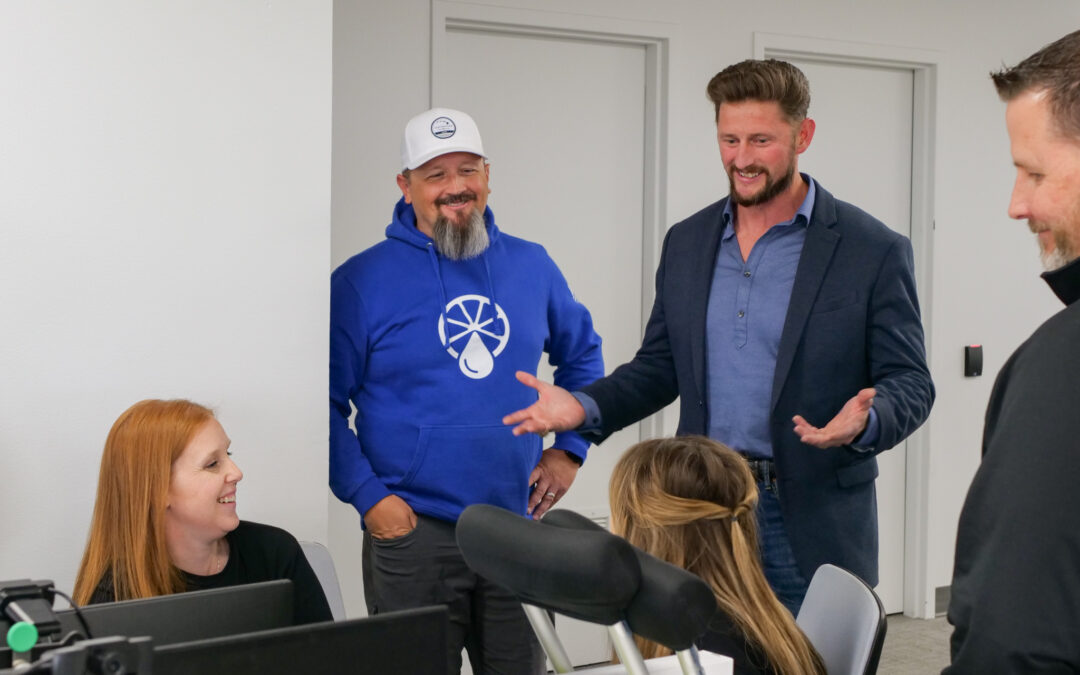Creating an Exceptional Sales Experience Within the 5 Steps of the Sales Process
Imagine your perfect vacation. What do you envision? The beach? The mountains? Disney World? What about food? Amenities? Lodging? Activities?
When planning a vacation, there are many factors that come into play. It’s not about one particular aspect alone—it is the entire experience.
And when we talk about sales experience, we’re not just talking about one aspect of business, either, but the buying experience as a whole. From first contact to close, there is the opportunity to build a consistent brand experience that will set you apart from the competition.
Your sales experience can make or break your company. Leave the consumer with a bad taste in their mouth and they won’t be coming back for more. But if you provide them with a delectable encounter that really stands out from the crowd (like that insane burger you had in Florida), chances are they won’t only come back for more, but they’ll bring their friends and family, too.
So how do you create an exceptional sales experience that builds your brand, boosts customer loyalty, and increases revenue?
Sales Experience Definition
Sales experience is the term used to define the customer buying experience as a whole. Every step of the customer journey, from prospecting to closing, is an opportunity to create a cohesive, on-brand experience your potential buyer can get behind.
Let’s break down the sales process and examine how we can cultivate an amazing sales experience during each step.
5 Steps of the Sales Process
- 1. Prospecting
The first step of the sales process is the task of prospecting. Like a miner digging for gold, you are searching for qualified customers to connect with. While some might think that a higher quantity of leads trumps quality leads, this is just not true. A successful company can’t afford to waste time, energy, and resources just picking and choosing who to call from a hat or on a whim. Time is money, and you want to make the most out of every call, email, or connection.
You can break down prospecting systematically into three simple steps:
- Formulate an Ideal Customer Profile (ICP). This gives your team a solid baseline of qualifications to look for when prospecting potential clients. It’s helpful to have a document your team can reference and use to keep them on task and focused on the goal.
Use data from real companies to create a mock business that represents everything you hope for in a client, including how the partnership will benefit you, and how your services will benefit the client. The most magical match (and an easier sale) comes from a union where everyone wins.
- Pinpoint Prospects. With your trusty ICP by your side, it’s pretty simple to then build a database of prospects who line up with that overview. Take your time and do your research. Look up the person or company you are interested in on social media such as Twitter, Tik-Tok, Instagram, or LinkedIn. We are big supporters of some good ol’ clean professional cyberstalking (all of this information is public anyway so it’s not creepy, we promise). The better you understand your prospect, the better you can tailor your cold calls, pitches, and demos to suit your prospects.
It’s kind of like getting to know someone and preparing to ask out on a first date. You’re more likely down the line to generate interest and score a second date if you show you’ve put in the effort to get to know the other person and create a personal experience right from the start.
- Pre-Qualify Leads. Depending on your unique set of qualifications, you’ll want to pre-qualify individual prospects before making the leap and reaching out. Understand the prospect’s budget, priority of need for your product or services, company size or likely expansion, location, etc. Identify the best means of communication for each potential lead so that when you do reach out, you have a better chance of connecting.
When developing your sales experience, you want every opportunity to stand out from the crowd. So whatever you do, don’t pass over prospecting. It may take time, but in the long run it will help you create a strong first impression and maximize your sales efforts exponentially.
- 2. Qualifying Leads
Now it’s time to initiate contact. This is where you find out if a prospect will transform into a qualified lead. Asking pertinent questions will help you discover if you’ve struck gold or if you need to move on. Be direct, friendly, and respectful of your prospect’s time (especially if this is a completely cold contact).
Cultivating a strong sales experience during this step doesn’t necessitate moving the prospect down your pipeline. While that’s obviously the goal of any sales campaign, it’s not the measure of success for sales experience. Just because a prospect doesn’t bite the first time (and many don’t), it doesn’t mean that they are a completely lost cause.
If you give your prospect a stellar and positive interaction, they will remember you. And if you continue to provide them with quality resources and content through your website and social media accounts, you’ll stay visible and be the first who comes to mind when they are in need of your products or services.
- 3. Nurturing Leads
Providing helpful and relevant resources can be the slow cooker version of nurturing leads, but active nurturing takes place in direct communication. If your lead shows interest and is qualified, you can dive deeper and continue the conversation.
This can look like further education on your products or services, scheduling a demo, whatever is needed to make your case and prove that you’re awesome and they should buy what you’re selling.
This is a unique dance that takes skill, especially as you strive to maintain a great sales experience. Your agents must be highly trained, knowledgeable in the industry, and able to navigate the twists and turns of a conversation smoothly. Whether you build your own in-house team from the bottom up or outsource your sales experience needs to a business partner (like Squeeze!), it’s crucial to have top-notch staff as they will be serving as the face of your company.
These interactions are key to building your company’s reputation as an authority in your field, providing relevant resources in a winsome way. It’s also a big opportunity to give a little taste of your company, so whatever your values are, let them shine in the way you nurture leads.
- 4. Handling Objections
How you handle a lead’s questions, concerns, and objections is a large part of making the sales experience a positive one. Some customers may approach their concerns more tactfully than others (to say the least). Your agents have to be prepared to be pressed and pushed on without crumbling, getting flustered, or even worse, becoming defensive or combative in their approach.
Empathy in business is crucial and it’s important that your team is well developed in this skill. Usually concerns such as price point, contract terms, or company risk are sensitive topics and require handling with genuine care and respect for the question or objection. Keep cool, be patient, and answer honestly and confidently. And make sure to touch in at the close of your explanation to ask if you really DID answer their question or address the concern to their satisfaction.
- 5. Closing the Sale
The stars have aligned, the company fits your ICP, they like you and want to move forward. Depending on the campaign, the close might take on different forms. It could be as simple as scheduling a meeting or product demonstration, or an actual “seal the deal” moment when your lead is ready to be transferred to your sales team and sign on the dotted line.
If you have a particular offer to sweeten the deal and really make their day, be sure to include that in the process. A free trial, special discount, or added value is a great way to show your lead your worth as a company and end this part of the sales experience on a high note.
And if your lead still isn’t sold? It doesn’t mean your efforts were for nothing. You can continue to follow up, nurture, and see where things go. If it’s a really hard “no,” treat it with respect and focus on more indirect nurturing tactics such as social media and helpful content.
But if it’s a “not now,” continue to follow up or reach out to other contacts within the company as time goes on. Whatever you do, don’t ghost and expect the company to come seek you out. Stay in the game and be consistent in cultivating a relationship and building trust. A company is far more likely to close with a company they feel they have a connection with than anyone else.
Best Business Hack EVER? Entrust Your Sales Experience to the Pros
The process of creating, cultivating, and maintaining a successful sales experience is a multi-faceted and complex endeavor, and one that can derail your marketing and sales teams if you’re not careful. Extra tasks wear on your team and can lead to frustration and dissatisfaction in the workplace if your teams aren’t able to just…do their jobs.
That was our motivation in establishing Squeeze. We wanted to help your company be as successful as it possibly can. So we set out to offer a true partnership with your company, one that fully integrates with your team and takes on the entire sales experience process so your business is streamlined, your teams can do what they’re hired to do, and everyone wins.
Sales experience is our JOB. It’s what we do, and we’re the best in the biz. Plus our plans are performance-based, so your success is our “get-up and go.” And with no contract, there’s no risk for you.
For reals. Just contact us today and prepare to take your sales experience to the next level!
Ready to squeeze the day?
Fill out the form below to contact us and start making the most out of your marketing!

